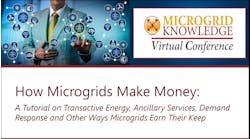The industry is trying to create a greener resilient microgrid, but it’s not easy, as Concord Engineering’s Michael Boswell explains.
Michael Boswell,
VP, distributed generation, Concord Engineering
Solar has been and continues to be an anchor renewable energy distributed energy resource (DER) for microgrids. But the shortcomings of photovoltaic (PV) solar as a DER that actually contributes to resiliency are annoyingly self-evident: Suffice it to say that when the sun doesn’t shine, or the grid goes down, PV solar alone isn’t contributing much of anything useful toward resiliency. And there is, of course, the amount of real estate required to generate meaningful volumes of electricity. All of that aside, PV solar is currently, without argument, the greenest widely available and affordable DER.
But back to resiliency. Maybe battery storage gets added into the PV solar microgrid. Battery storage coupled to PV solar provides the technical means to seamlessly transition to an island microgrid if and when the grid goes down, and it can give some added heft to smooth out some of the other disagreeable technical characteristics of PV solar — such as susceptibility to being yanked around by the host electrical loads. But for how long can the battery discharge and at what cost? An old mentor of mine used to say, “I can solve any problem you have if it takes all the money you got.” That was always good for a nervous chuckle, but shortly thereafter, we would have to get on with solving the problem at hand.
Extended discharge time for batteries is expensive, and there is, of course, the tricky calculus of sizing the available PV solar to charge the battery while simultaneously carrying the load of the microgrid. One can also add in load shedding and load management, and the design and operations get a bit more complicated. But the real complication is not the technology. It is all there, ready and proven. The primary complications are the economics – but that is a topic for another day.
Let’s put aside the PV solar concepts discussed above and perhaps agree that, for now, the most practical DERs for resiliency are arguably combustion or chemical platforms such as IC engines, combustion turbines or fuel cells — which, with the exception of a microgrid closely coupled to a renewable fuel source, leaves these DERs fueled with a fossil fuel. This contributes to resiliency, but not so much to the “greening” of the microgrid.
A fully green microgrid is a difficult proposition, and the costs to achieving net zero carbon imprint are not trivial, but the trends are toward lower costs.
So, what does that leave us for a resilient microgrid that is of low or zero carbon imprint? The most practical near-term solution is perhaps to simply purchase solar or wind renewable energy credits (RECs). In this case, the “greening” of the microgrid is through a contract for the attributes of a renewable or low carbon fuel to be used by the fossil fuel burning DER. The most prevalent means to adopt this strategy is by purchasing renewable natural gas (RNG) by way of contracting for a volume of RNG having been assigned a renewable identification number (RIN).
shutterstock.com
Much like a solar or wind REC, RNG would be generated and injected into a distribution pipeline, contributing to a benefit that is transferred through a contract recognizing and monetizing that benefit — the so-called RIN.
Hydrogen or hydrogen blended into natural gas is a possibility and the market and technical trends are toward greater market penetration, lower costs and contract mechanisms similar to RINs that make hydrogen a renewable fuel for the distributed energy resources viable.
One could, of course, also purchase carbon offsets to mitigate the carbon generated by burning fossil fuels within the boundary of the microgrid. But, to some, carbon offsets may lack the transparency of being linked directly to the fuel source, even if the link is a transaction.
Finally — though a bit of an outlier, at least for now — is fuel cell carbon capture. There are multiple possible iterations of this concept, but, simply put, fuel cells would be designed as part of the DER mix with the fuel feed stock consisting of natural gas, RNG or hydrogen blended natural gas. The greening occurs through the capture of carbon and either sequestering, selling or using CO2 as an industrial gas. This concept has a great deal of merit in the food and beverage industries. Additional flexibility can be designed into this process by using flue gas from a boiler or even IC engine DER. This technology and application are not yet mature, but certainly has promise.
A fully green microgrid is a difficult proposition, and the costs to achieving net zero carbon imprint are not trivial, but the trends are toward lower costs. And, simply put, a microgrid has more flexibility to a site host valuing resiliency and lower carbon impact than what can be achieved by the grid alone.
Michael Boswell is VP of distributed generation projects at Concord Engineering.










